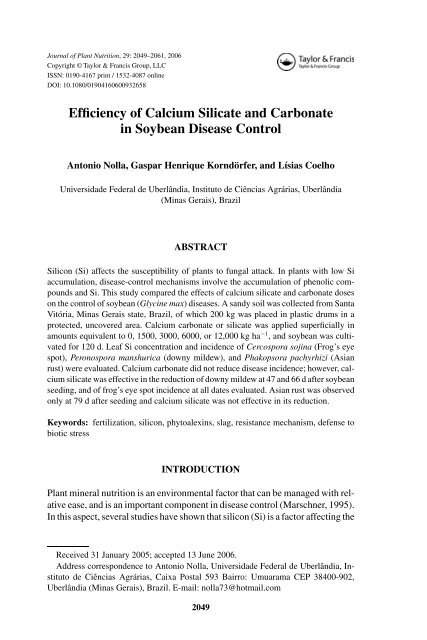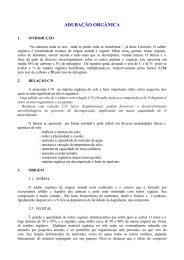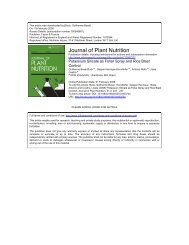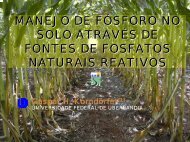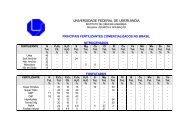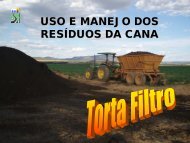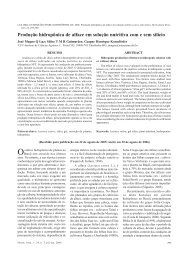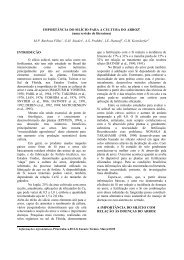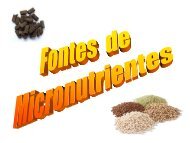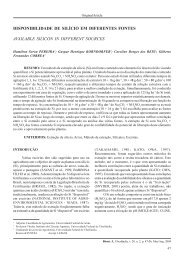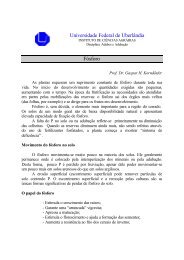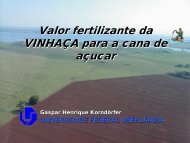Efficiency of Calcium Silicate and Carbonate in Soybean Disease ...
Efficiency of Calcium Silicate and Carbonate in Soybean Disease ...
Efficiency of Calcium Silicate and Carbonate in Soybean Disease ...
- No tags were found...
You also want an ePaper? Increase the reach of your titles
YUMPU automatically turns print PDFs into web optimized ePapers that Google loves.
2050 A. Nolla et al.susceptibility <strong>of</strong> cereals, such as rice (Oryza sativa) <strong>and</strong> several dicotyledons,to fungal attack (Jones <strong>and</strong> H<strong>and</strong>reck, 1967; Menzies <strong>and</strong> Bélanger, 1996).Many <strong>in</strong>dependent studies have confirmed the importance <strong>of</strong> Si <strong>in</strong> resistanceto abiotic [iron (Fe), manganese (Mn), <strong>and</strong> sodium (Na) toxicity] <strong>and</strong>biotic (<strong>in</strong>sects <strong>and</strong> fungi) stresses. Silicon accumulation <strong>and</strong> deposition <strong>in</strong> theepidermal cells can be an effective mechanical barrier to fungal penetration.However, the mechanical barrier made by Si <strong>in</strong> the epidermal cells is not theonly mechanism <strong>of</strong> prevention <strong>of</strong> fungal penetration or <strong>in</strong>sect attack. Recentresearch results suggest that Si acts <strong>in</strong> the host tissue by alter<strong>in</strong>g the signals betweenhost <strong>and</strong> pathogen, result<strong>in</strong>g <strong>in</strong> a faster <strong>and</strong> more extensive activation <strong>of</strong>plant defense mechanisms, as shown for cucumber (Cucumis sativas) (Samuelset al., 1991; Chérif et al., 1994; Marschner, 1995).Silicon can form complexes with phenolic compounds <strong>and</strong> <strong>in</strong>crease theirsynthesis <strong>and</strong> mobility <strong>in</strong> the apoplasm (Menzies et al., 1991). A quick deposition<strong>of</strong> phenolic compounds or lign<strong>in</strong> <strong>in</strong> the <strong>in</strong>fection courts is a defensemechanism aga<strong>in</strong>st a fungal attack, <strong>and</strong> the presence <strong>of</strong> soluble Si facilitatesthis resistance mechanism (Menzies et al., 1991).Plant resistance to diseases can be enhanced by the alteration <strong>of</strong> plantresponses to a pathogen challenge, by <strong>in</strong>creas<strong>in</strong>g tox<strong>in</strong> synthesis (phytoalex<strong>in</strong>s),which can act as <strong>in</strong>hibitory <strong>and</strong> repellent substances, or by promot<strong>in</strong>g theformation <strong>of</strong> biochemical barriers (Marschner, 1995). Phytoalex<strong>in</strong>s are smallmolecules produced <strong>in</strong> the plant after a microorganism <strong>in</strong>fection or stress <strong>and</strong>play an important role <strong>in</strong> resistance to diseases <strong>and</strong> pests. Frequently, phytoalex<strong>in</strong>sare also toxic to the host, kill<strong>in</strong>g the cells as it is accumulated. Resistanceto a pathogen is observed when these compounds accumulate quickly <strong>and</strong> <strong>in</strong>high concentrations <strong>in</strong> the <strong>in</strong>fection court, result<strong>in</strong>g <strong>in</strong> pathogen death (Fosket,1994). Several flavonoids <strong>in</strong> legume (e.g. peas, soybean) root exudates canact as suppressors <strong>of</strong> certa<strong>in</strong> pathogenic fungi, <strong>and</strong> are considered phytoalex<strong>in</strong>s(Dixon, 1986; Hartwig, 1994). In plant-pathogen <strong>in</strong>teractions, certa<strong>in</strong> f<strong>in</strong>alproducts <strong>of</strong> flavonoid biosynthesis act as phytoalex<strong>in</strong>s <strong>in</strong> plant defense reactions(Hahlbrock <strong>and</strong> Scheel, 1989; Peters <strong>and</strong> Verma, 1990).Broad-leaf plants, such as soybean <strong>and</strong> cucumber, are characterized <strong>in</strong>relation to Si contents <strong>and</strong> proportions <strong>of</strong> Si/<strong>Calcium</strong> (Ca) as <strong>in</strong>termediate (1%–3% dry weight), mean<strong>in</strong>g that when the Si concentration <strong>in</strong> the environmentis high, the plants conta<strong>in</strong> a considerable amount <strong>of</strong> Si; there is evidence thatthese plants transport Si freely from the root system to their canopies (Miyake<strong>and</strong> Takahashi, 1995).<strong>Soybean</strong> stem canker is a disease caused by a fungus with two developmentalphases: (1) the anamorph, called Phomopsis phaseolif. sp. meridionalis,found <strong>in</strong> <strong>in</strong>fected tissues, which dissem<strong>in</strong>ates through conidia, produced <strong>in</strong> pycnidia,dur<strong>in</strong>g the grow<strong>in</strong>g season; <strong>and</strong> (2) the teleomorph, known as Diaporthephaseolorum f. sp. meridionalis (Dpm) (Morgan-Jones, 1989), responsible forthe first <strong>in</strong>fections <strong>in</strong> the subsequent grow<strong>in</strong>g season. Juliatti et al. (1996) <strong>and</strong>Grothge-Lima (1998) noted that the use <strong>of</strong> calcium silicate <strong>in</strong> the soil, as a
<strong>Calcium</strong> <strong>Silicate</strong> on <strong>Soybean</strong> <strong>Disease</strong> Control 2051corrective <strong>and</strong> a Si source, <strong>in</strong>creased soybean resistance to stem canker. Lesionlength, caused by the fungus <strong>in</strong> the pith <strong>of</strong> diseased plants, was decreased upto 90%. This lesion decrease was l<strong>in</strong>ear with the addition <strong>of</strong> up to 40 mg L −1Si to the nutrient medium (Grothge-Lima, 1998). However, no effect was observedon leaf application <strong>of</strong> Si. This lack <strong>of</strong> control could be attributed to Siimmobility <strong>in</strong> the plant, h<strong>in</strong>der<strong>in</strong>g its movement to the <strong>in</strong>fection court, or to itssole movement <strong>in</strong> the apoplast. Because soybean is an <strong>in</strong>termediate type plant,i.e., it absorbs <strong>and</strong> translocates appreciable amounts <strong>of</strong> Si when Si is available<strong>in</strong> large amounts <strong>in</strong> the substrate, provid<strong>in</strong>g Si through a nutrient solution couldenhance plant resistance to diseases.<strong>Disease</strong> management has been accomplished through resistant cultivars<strong>and</strong> the use <strong>of</strong> fungicides. Although these methods reduce disease problems,new pathogen races can break resistance with<strong>in</strong> a few years after <strong>in</strong>troduction <strong>of</strong>a cultivar. Also, fungicide use is considered a high-technology <strong>in</strong>put, not alwaysavailable for small farmers, <strong>in</strong> addition to besides be<strong>in</strong>g a source <strong>of</strong> pollution<strong>in</strong> the environment when due care is not taken <strong>in</strong> its h<strong>and</strong>l<strong>in</strong>g <strong>and</strong> spray<strong>in</strong>g.As a consequence, the use <strong>of</strong> more susta<strong>in</strong>able strategies for disease controlis highly desirable. M<strong>in</strong>eral nutrition as a means to <strong>in</strong>crease plant resistanceis susta<strong>in</strong>able <strong>and</strong> contributes to soil conservation <strong>and</strong> to the ma<strong>in</strong>tenance <strong>of</strong>human health. Silicon fertilization may provide an alternative that avoids theseproblems, as research from several countries has shown.This study compared the effect <strong>of</strong> calcium carbonate <strong>and</strong> calcium silicatedoses soybean disease control.MATERIALS AND METHODSSoil classified as Ustoxic Quartzipsamment (USA, 1998), was collected <strong>in</strong> SantaVitória County, located <strong>in</strong> the state <strong>of</strong> M<strong>in</strong>as Gerais, Brazil, <strong>in</strong> a native forestformation; its chemical characterization is described <strong>in</strong> Table 1. Its soil wasTable 1Chemical characteristics <strong>of</strong> the Ustoxic Quartzipsamment soil used <strong>in</strong> the experimentpH (H 2 O) Ca Mg Al VP K H + Al VCEC B.S. m O.M. Si1:2.5 cmol c dm −3 mg·dm −3 cmol c dm −3 % g kg −1 mg kg −14.6 0.1 0.1 0.7 1.3 19 4.5 4.77 5 74 17 0.6Ca, Mg, Al = (extractor − KCl 1 N); P, K = (extractor − HCl 0.05 N + H 2 SO 40.025 N); H + Al = potential acidity (extractor – calcium acetate); T = CTC pH 7; V= base saturation; MO = (Walkley-Black); Si = (extractor – CaCl 2 0.01 mol L −1 ).CEC = cation exchange capacity; B.S. = base saturation; m = alum<strong>in</strong>um saturation;O.M. = organic matter.
2052 A. Nolla et al.selected due to its low concentration <strong>of</strong> available Si (s<strong>and</strong>y texture) (Beckwith<strong>and</strong> Reeve, 1963) <strong>and</strong>, consequently, greater probability <strong>of</strong> plant response tosoil application <strong>of</strong> that element.Due to the naturally low fertility <strong>of</strong> the soil collected, soil fertilization wasperformed by add<strong>in</strong>g, with the aid <strong>of</strong> a concrete mixer, the equivalent <strong>of</strong> 400 kgP 2 O 5 ha −1 , 400 kg K 2 Oha −1 , 240 kg magnesium (Mg) ha −1 , <strong>and</strong> 100 kg <strong>of</strong> amicronutrient fertilizer <strong>in</strong> the form <strong>of</strong> frited trace element (FTE) [9% z<strong>in</strong>c (Zn),1.8% boron (B), 2% manganese (Mn), 0.8% copper (Cu), 0.1% molybdenum(Mo), <strong>and</strong> 3% iron (Fe)]. Subsequently, 200 kg lots <strong>of</strong> the soil were placed <strong>in</strong>250 L drums 54 cm <strong>in</strong> diameter × 83 cm <strong>in</strong> height. The drums were placed<strong>in</strong> an open <strong>and</strong> fenced area over crushed rocks to avoid contam<strong>in</strong>ation <strong>of</strong> thesoil <strong>in</strong> the columns. Excess water <strong>in</strong> the columns was avoided by punch<strong>in</strong>g five1.3 cm diameter holes <strong>in</strong>to the upper <strong>and</strong> lower ends <strong>of</strong> the side <strong>of</strong> the drum.The equivalent <strong>of</strong> 0, 1500, 3000 (lim<strong>in</strong>g requirement), 6000, <strong>and</strong>12,000 kg ha −1 calcium carbonate (99% CaCO 3 )orcalcium silicate, providedby the company Rockfibras do Brasil (18% CaO <strong>and</strong> 40% SiO 2 ), was appliedto the column surface (without <strong>in</strong>corporation), <strong>in</strong> a r<strong>and</strong>omized block designwith four repetitions, as a 2 × 5factorial experiment (two materials <strong>and</strong> fivedoses). The soil columns were left fallow for 15 d, then irrigated with 12 L <strong>of</strong>water immediately after the application <strong>of</strong> the corrective materials to allow fora better reactivity with the soil.The soybean cultivar used was BRS/MG-68 ‘Vencedora,’ which has a determ<strong>in</strong>ategrowth habit; average plant height <strong>of</strong> 80 cm; average <strong>in</strong>sertion height <strong>of</strong>the first pod <strong>of</strong> 15 cm; purple-colored flowers; brown pubescence; black hilum;good resistance to stalk<strong>in</strong>g; good seed quality <strong>and</strong> resistance to frog’s eye spot(Cercospora soj<strong>in</strong>a), bacterial pustule (Xanthomonas campestris pv glyc<strong>in</strong>ea),bacterial blight (Pseudomonas syr<strong>in</strong>gae pv glyc<strong>in</strong>ea), powdery mildew (Microsphaeradiffusa), <strong>and</strong> stem canker (Phomopsis phaseoli f.sp. meridionalis).This cultivar is also tolerant to the gall nematodes (Meloydog<strong>in</strong>e <strong>in</strong>cognita<strong>and</strong> M. javanica); however, it is susceptible to the cyst nematode (Heteroderaglyc<strong>in</strong>es) (EMBRAPA, 2004).Twenty Bradyrhizobium japonicum pre-<strong>in</strong>oculated seeds were planted onDecember 23, 2003 <strong>in</strong> the drums, <strong>in</strong> two rows spaced at 0.25 cm, <strong>and</strong> wereth<strong>in</strong>ned to five plants per row. <strong>Soybean</strong> seeds were not fungicide treated, so diseasedevelopment could be monitored dur<strong>in</strong>g the culture cycle. The experimentsimulated direct plant<strong>in</strong>g <strong>and</strong> culture rotation with sugar cane (Saccharum <strong>of</strong>fic<strong>in</strong>arum);therefore, the equivalent <strong>of</strong> 10 mg ha −1 sugar cane straw mulch wasapplied to the surface <strong>of</strong> the drums. The soil moisture was ma<strong>in</strong>ta<strong>in</strong>ed throughra<strong>in</strong>fall or by irrigation (with tap water) dur<strong>in</strong>g the dry season.Only an <strong>in</strong>secticide was used for pest (Nezara viridula) control dur<strong>in</strong>gthe culture cycle. Evaluation for disease (Peronospora manshurica—Downymildew, Cercospora soj<strong>in</strong>a—frog’s eye spot, <strong>and</strong> Phakopsora pachyrhizi—Asian rust) was performed at 47, 66, <strong>and</strong> 79 d after plant seed<strong>in</strong>g. Three plantswere selected per drum, <strong>and</strong> disease was evaluated us<strong>in</strong>g the Horsfall <strong>and</strong> Barrat
<strong>Calcium</strong> <strong>Silicate</strong> on <strong>Soybean</strong> <strong>Disease</strong> Control 2053scale (Kranz, 1990), assess<strong>in</strong>g disease <strong>in</strong>cidence by visual evaluation as a percentage<strong>of</strong> leaves affected per plant by each pathogen.<strong>Soybean</strong> leaves were collected for nutrient analysis at the flower<strong>in</strong>g stage(R 1 ) (Ritchie et al., 1982) by pick<strong>in</strong>g 30 fully exp<strong>and</strong>ed leaves without theirpedicels (third leaf from the top meristem <strong>of</strong> the stem). Leaf Si content wasdeterm<strong>in</strong>ed us<strong>in</strong>g the yellow method (Elliot <strong>and</strong> Snyder, 1991).Harvest was performed 120 d after seed<strong>in</strong>g; however, Phakopsorapachyrhizi (Asian rust) severity compromised plant development <strong>and</strong> pod productivity<strong>in</strong> the experiment, which had to be term<strong>in</strong>ated earlier than planned.Therefore, the soybean canopy was cut <strong>and</strong> ma<strong>in</strong>ta<strong>in</strong>ed as mulch for a subsequentexperiment.All <strong>of</strong> the data were submitted to analysis <strong>of</strong> variance, us<strong>in</strong>g the statisticsprogram SANEST (Machado <strong>and</strong> Zonta, 1991) <strong>and</strong> the averages compared bythe Tukey test at 5% probability.RESULTS AND DISCUSSIONTissue Si content <strong>in</strong> soybean demonstrated that, <strong>in</strong> general, soybean cultivated oncalcium carbonate-treated soil accumulated little Si <strong>in</strong> the leaves (Figure 1), aswasexpected, because calcium carbonate does not have Si <strong>in</strong> its composition; thes<strong>and</strong>y soil had little available Si; <strong>and</strong> soybean is an <strong>in</strong>termediate accumulat<strong>in</strong>gplant for Si. Accord<strong>in</strong>g to Marschner (1995), soybean accumulates less than0.23% Si <strong>in</strong> its tissues. However, under the silicate treatments, greater leafSi content was observed, than under the carbonate treatments. Application <strong>of</strong>Figure 1. Leaf Si concentration (%) <strong>in</strong> soybean cultivar BRS/MG-68 ‘Vencedora,’ as afunction <strong>of</strong> the application <strong>of</strong> <strong>in</strong>creas<strong>in</strong>g doses <strong>of</strong> calcium carbonate or silicate.
2054 A. Nolla et al.calcium silicate <strong>in</strong>creased leaf Si concentration up to 1.70 fold, vary<strong>in</strong>g from0.34% to 0.55% if silicate was applied at doses <strong>of</strong> 0 or 12 mg ha −1 (Figure 1).These values were higher than those reported by Grothge-Lima et al. (1998)(0.02%–0.45%) after the application <strong>of</strong> 0 or 100 mg Si kg −1 (Si metasilicate—Na 2 SiO 3·5H 2 O) <strong>in</strong> nutrient solution. These differences could be expla<strong>in</strong>ed bythe sampl<strong>in</strong>g method adopted <strong>in</strong> each study. Here, the third leaf pair at flower<strong>in</strong>gstage (stage R 1 ), was sampled, whereas Grothge-Lima et al. (1998), sampledstem <strong>and</strong> leaves at stage V 1 . Therefore, a longer growth period was allowed, <strong>and</strong>the plant tissues analyzed could expla<strong>in</strong> the different Si contents between thetwo studies. Also, the <strong>in</strong>crease <strong>in</strong> Si content under the treatments where silicatewas applied was significant because the soil (Ustoxic Quartzipsamment) studiedhad low natural availability <strong>of</strong> Si (0.6 mg dm −3 ).The <strong>in</strong>crease <strong>in</strong> leaf Si concentration <strong>in</strong> soybean under the treatments wheresilicate was applied is desirable, as supply<strong>in</strong>g silicate has been shown to contributeto reduction <strong>of</strong> Fusarium solani (soybean sudden-death syndrome) <strong>and</strong>stem canker <strong>in</strong> soybean plants (Juliatti et al., 2003). In cucumber, Si acts <strong>in</strong> thehost tissue, affect<strong>in</strong>g signal<strong>in</strong>g between host <strong>and</strong> pathogen, which results <strong>in</strong> afaster <strong>and</strong> more extensive activation <strong>of</strong> plant defense mechanisms, probably asa function <strong>of</strong> phytoalex<strong>in</strong> production (Samuels et al., 1991; Chérif et al., 1994).The observation <strong>of</strong> downy mildew <strong>in</strong>cidence on soybean leaves at 47, 66,or 79 d after seed<strong>in</strong>g <strong>in</strong>dicated that the disease was not controlled <strong>in</strong> the calciumcarbonate plots (Figure 2). However, there was a reduction <strong>of</strong> downy mildew <strong>in</strong>cidenceunder the silicate treatments, especially at 47 d after seed<strong>in</strong>g (Figure 2a),from 85% (no silicate) to 65% (12 mg ha −1 calcium silicate), demonstrat<strong>in</strong>g theefficacy <strong>of</strong> Si <strong>in</strong> disease control <strong>in</strong> the first evaluation. This reduction probablyoccurred as a function <strong>of</strong> greater Si accumulation <strong>in</strong> soybean leaf tissue underthe silicate treatments (Figure 1). It is expected that, <strong>in</strong> cropp<strong>in</strong>g areas, thisreduction <strong>in</strong> disease <strong>in</strong>cidence after soil <strong>in</strong>corporation <strong>of</strong> calcium silicate couldalso result <strong>in</strong> a reduction <strong>in</strong> use <strong>of</strong> fungicide sprays, as well as lead to a greateryield due to the longer ma<strong>in</strong>tenance <strong>of</strong> photosynthesiz<strong>in</strong>g area.There was no difference <strong>in</strong> downy mildew <strong>in</strong>cidence 66 d after seed<strong>in</strong>g(Figure 2b); however, where calcium carbonate was applied, there was a trend<strong>of</strong> greater <strong>in</strong>cidence (90%–100%) than where silicate was applied (81%–92%).This result demonstrates, once aga<strong>in</strong>, that the application <strong>of</strong> calcium silicate wasmore effective for disease control, possibly due to the activation <strong>of</strong> biochemicalmechanisms <strong>of</strong> plant defense (Korndörfer et al., 2004). In the last evaluation(Figure 2c), 79 d after seed<strong>in</strong>g, downy mildew <strong>in</strong>cidence was 100% under thelim<strong>in</strong>g treatment. Similarly, under the silicate treatments, disease <strong>in</strong>cidence wasnear 100%, vary<strong>in</strong>g from 96% to 100%. Accord<strong>in</strong>g to Korndörfer et al. (2004),the <strong>in</strong>corporation <strong>of</strong> silicate <strong>in</strong>to the soil does not prevent disease <strong>in</strong>cidence;however, as observed here, it can delay disease onset <strong>and</strong> reduce its <strong>in</strong>cidenceearly <strong>in</strong> the growth season. This action is highly desirable, especially consider<strong>in</strong>gthat disease control with fungicides can be delayed, <strong>and</strong> the number <strong>of</strong>sprays reduced, thus reduc<strong>in</strong>g production costs.
<strong>Calcium</strong> <strong>Silicate</strong> on <strong>Soybean</strong> <strong>Disease</strong> Control 2055Figure 2. Leaf <strong>in</strong>cidence (%) <strong>of</strong> downy mildew (Peronospora manshurica)<strong>in</strong>soybeancultivar BRS/MG-68 ‘Vencedora’ at (a) 47, (b) 66, <strong>and</strong> (c) 79 d after seed<strong>in</strong>g, as afunction <strong>of</strong> the application <strong>of</strong> <strong>in</strong>creas<strong>in</strong>g doses <strong>of</strong> calcium carbonate or silicate.Frog’s eye spot was another disease observed dur<strong>in</strong>g the culture cycle.Although the cultivar BRS/MG-68 ‘Vencedora’ is resistant to this disease(EMBRAPA, 2004), the disease was observed <strong>in</strong> the experiment, probably dueto favorable environmental conditions. In general, compar<strong>in</strong>g leaf disease <strong>in</strong>cidence,at 47, 66, <strong>and</strong> 79 d after seed<strong>in</strong>g, it was noted that calcium carbonate didnot control the disease (Figure 3). However, under the silicate treatments, therewas asignificant reduction <strong>of</strong> frog’s eye spot <strong>in</strong>cidence at 47 d (Figure 3a),from 81% (no silicate) to 14% (12 mg ha −1 calcium silicate), emphasiz<strong>in</strong>gthe importance <strong>of</strong> silicate use for control <strong>of</strong> frog’s eye spot <strong>in</strong> the first evaluation.This disease reduction is <strong>in</strong>terest<strong>in</strong>g, for uncontrolled frog’s eye spot canlead to a yield loss <strong>of</strong> up to 22% (Gupta, 2004). In contrast with its effect ondowny mildew (a reduction <strong>of</strong> up to 20%, Figure 2a), Si was very effective onfrog’s eye spot control (show<strong>in</strong>g a reduction <strong>of</strong> up to 67%; Figure 3a). Frog’seye spot <strong>in</strong>cidence (Figure 3) was <strong>in</strong>versely proportional to leaf Si concentration(Figure 1). Although soybean accumulates little Si <strong>in</strong> leaf tissues (up to0.55%), the results reported here corroborate that Si reduced frog’s eye spoton the leaves. Possibly, Si accumulation <strong>in</strong> leaf tissues affected host-pathogen
2056 A. Nolla et al.Figure 3. Leaf <strong>in</strong>cidence (%) <strong>of</strong> frog’s eye spot (Cercospora soj<strong>in</strong>a)<strong>in</strong>soybean cultivarBRS/MG-68 ‘Vencedora’ at (a) 47, (b) 66, <strong>and</strong> (c) 79 d after seed<strong>in</strong>g, as a function <strong>of</strong>the application <strong>of</strong> <strong>in</strong>creas<strong>in</strong>g doses <strong>of</strong> calcium carbonate or silicate.signal<strong>in</strong>g, hamper<strong>in</strong>g fungal metabolism, <strong>and</strong> quickly activated plant defensemechanisms, as has been observed <strong>in</strong> cucumbers (Samuels et al., 1991; Chérifet al., 1994; Marschner, 1995; Korndörfer et al., 2004). Therefore, it is importantto highlight that the presence <strong>of</strong> Si <strong>in</strong> leaf tissue can be fundamental to<strong>in</strong>creas<strong>in</strong>g plant resistance to diseases as a function <strong>of</strong> tox<strong>in</strong> synthesis (phytoalex<strong>in</strong>s),which can act as <strong>in</strong>hibitory or repellent substances for pathogens<strong>and</strong> pests (Marschner, 1995; Grothge-Lima, 1998; Korndörfer et al., 2003).<strong>Calcium</strong> carbonate was not effective for the control <strong>of</strong> frog’s eye spot at 66 dafter seed<strong>in</strong>g (Figure 3b), as expected. Greater resistance to frog’s eye spot wasstill observed under the silicate treatments, which ma<strong>in</strong>ta<strong>in</strong>ed the same controllevel as at 47 d (Figure 3a), vary<strong>in</strong>g from 75% (no silicate) to 14% (12 mg ha −1calcium silicate) (Figure 3b). This significant reduction <strong>in</strong> disease <strong>in</strong>cidencedemonstrated the efficacy <strong>of</strong> silicate dur<strong>in</strong>g a good part <strong>of</strong> the culture cycle (upto 66 d after seed<strong>in</strong>g). These results are <strong>in</strong> agreement with those <strong>of</strong> Juliatti et al.(1996), who found greater control <strong>of</strong> Cercospora blight (Cercospora carotae)<strong>and</strong> Alternaria blight (Alternaria dauci)<strong>in</strong>carrot (Daucus carota) treated with
<strong>Calcium</strong> <strong>Silicate</strong> on <strong>Soybean</strong> <strong>Disease</strong> Control 2057different sources <strong>of</strong> silicate. Therefore, a reduction <strong>in</strong> the number <strong>of</strong> sprays forcontrol <strong>of</strong> frog’s eye spot can be expected follow<strong>in</strong>g <strong>in</strong>corporation <strong>of</strong> silicate tothe soil. Juliatti et al. (2004a) also observed a reduction <strong>of</strong> up to 50% <strong>in</strong> suddendeathsyndrome <strong>and</strong> stem canker on soybean after silicate <strong>in</strong>corporation <strong>in</strong>tothe soil. Santos (2002) <strong>and</strong> Pozza <strong>and</strong> Pozza (2003) also noted the efficacy<strong>of</strong> silicate on the control <strong>of</strong> c<strong>of</strong>fee frog’s eye spot (Cercospora c<strong>of</strong>feicola).The resistance mechanism <strong>of</strong> host resistance to the pathogen was probably abiochemical barrier (Bélanger, 2003) or the production <strong>of</strong> phenol chit<strong>in</strong>ases <strong>and</strong>peroxidases (Chérif et al., 1994; Fawe, et al., 1998; Epste<strong>in</strong>, 1999).Frog’s eye spot <strong>in</strong>cidence <strong>in</strong>creased later <strong>in</strong> the season, as observed fordowny mildew (Figure 3c). There was no disease control under the calciumcarbonate treatments, <strong>and</strong> the number <strong>of</strong> diseased plants was greater than 96%;however, under the silicate treatments, disease <strong>in</strong>cidence varied from 100% (nosilicate) to 71% (12 mg ha −1 calcium silicate). This effect probably occurredbecause no disease control measures were employed, <strong>and</strong> conduct<strong>in</strong>g the test <strong>in</strong>an open area favored fungal proliferation. Moreover, it is important to note that79 d after seed<strong>in</strong>g, soybean was already flower<strong>in</strong>g (R 1 ), <strong>and</strong> between flower<strong>in</strong>g<strong>and</strong> gra<strong>in</strong> fill<strong>in</strong>g, water <strong>and</strong> nutrient requirements are at their maximum (Costa,1996); thus, the high nutrient requirement at this stage could reduce soybeannatural resistance to diseases such as downy mildew (Figure 2c) <strong>and</strong> frog’s eyespot (Figure 3c). Accord<strong>in</strong>g to observations by Korndörfer et al. (2004), soil<strong>in</strong>corporation <strong>of</strong> Si sources does not elim<strong>in</strong>ate disease <strong>in</strong>cidence. However, asobserved by Juliatti et al. (2004b), results <strong>of</strong> disease <strong>in</strong>cidence on soybean could<strong>in</strong>dicate that field <strong>in</strong>corporation <strong>of</strong> silicate has been important <strong>in</strong> a reduction<strong>of</strong> the number <strong>of</strong> fungicide sprays early <strong>in</strong> the grow<strong>in</strong>g season, <strong>in</strong>creas<strong>in</strong>g thegrower’s sav<strong>in</strong>gs.Nowadays, soybean Asian rust is the most worrisome disease due to its aggressiveness<strong>and</strong> dissem<strong>in</strong>ation speed. In the agricultural year 2003, a m<strong>in</strong>imum<strong>of</strong> two fungicide sprays were required <strong>in</strong> 80% <strong>of</strong> the soybean area, dem<strong>and</strong><strong>in</strong>gimmediate action <strong>and</strong> generat<strong>in</strong>g extra expense (Yor<strong>in</strong>ori, 2004; Oliveira,2004; Juliatti et al., 2004a). In this study, Asian rust was not observed at 47or 66 d after seed<strong>in</strong>g. However, due to the number <strong>of</strong> <strong>in</strong>fections <strong>and</strong> extremelyfast disease progress, at 79 d disease <strong>in</strong>cidence was greater than 96.5% underall treatments, <strong>in</strong>clud<strong>in</strong>g those with calcium silicate. It is possible that this diseaseprogress occurred because soybean was at the flower<strong>in</strong>g stage (R1) <strong>and</strong>,accord<strong>in</strong>g to Julliati et al. (2004a), Asian rust is commonly observed at thisstage. It was expected that leaf Si accumulation (Figure 1) would be effectiveaga<strong>in</strong>st the rust, as it was for downy mildew <strong>and</strong> frog’s eye spot. In this study,to evaluate the effect <strong>of</strong> Si on disease control, no chemical control measureswere adopted. Asian rust aggressiveness was so <strong>in</strong>tense that, <strong>in</strong> 7 d, disease hadpropagated throughout the experiment (Figure 4), lead<strong>in</strong>g to premature leafdrop, pod abortion, <strong>and</strong> complete compromise <strong>of</strong> yield evaluation <strong>and</strong> gra<strong>in</strong>production. Accord<strong>in</strong>g to Yor<strong>in</strong>ori (2004), the recommendation for Asian rustcontrol is the correct use <strong>of</strong> adequate doses <strong>of</strong> proper fungicides.
2058 A. Nolla et al.Figure 4. Leaf <strong>in</strong>cidence (%) <strong>of</strong> Asian rust (Phakopsora pachyrhizi) onsoybean cultivarBRS/MG-68, ‘Vencedora’ 79 d after seed<strong>in</strong>g, as a function <strong>of</strong> the application <strong>of</strong><strong>in</strong>creas<strong>in</strong>g doses <strong>of</strong> calcium carbonate or silicate.It is possible that the <strong>in</strong>crease <strong>in</strong> frog’s eye spot (Figure 2) <strong>and</strong> downymildew (Figure 3) <strong>in</strong>cidence at 79 d after seed<strong>in</strong>g could be due to the occurrence<strong>of</strong> Asian rust <strong>in</strong> the soybeans (Figure 4), thus favor<strong>in</strong>g the development <strong>of</strong>diseases <strong>in</strong> all treatments. This <strong>in</strong>crease <strong>in</strong> disease <strong>in</strong>cidence, <strong>in</strong> turn, couldmean that Si use would be effective for the control <strong>of</strong> diseases that are not asaggressive, such as frog’s eye spot <strong>and</strong> downy mildew.CONCLUSIONSA pre-seed<strong>in</strong>g soil application <strong>of</strong> silicate <strong>in</strong>creased leaf-tissue silicate concentration.This greater leaf concentration was effective on reduc<strong>in</strong>g downy mildew<strong>in</strong>cidence at 47 or 66 d after seed<strong>in</strong>g, <strong>and</strong> frog’s eye spot at all evaluations; however,no control <strong>of</strong> Asian rust was observed. In contrast, calcium carbonate didnot reduce frog’s eye spot, downy mildew, or Asian rust <strong>in</strong>cidence.ACKNOWLEDGMENTSThe authors acknowledge the Brazilian National Research Council (CNPq) forf<strong>in</strong>ancial support <strong>and</strong> fellowships.REFERENCESBeckwith, R. S., <strong>and</strong> R. Reeve. 1963. Studies on soluble silica <strong>in</strong> soils. 1.The sorption <strong>of</strong> Si acid by soils <strong>and</strong> m<strong>in</strong>erals. Australian Journal <strong>of</strong> SoilResearch 1: 157–168.
<strong>Calcium</strong> <strong>Silicate</strong> on <strong>Soybean</strong> <strong>Disease</strong> Control 2059Bélanger, R. R., N. Behamou, <strong>and</strong> J. G. Menzies. 2003. Cytological evidence <strong>of</strong>an active role <strong>of</strong> silicon on wheat resistance to powdery mildew (Blumeriagram<strong>in</strong>is f.sp. tritici). Phytopathology 23: 402–412.Chérif, M., A. Assel<strong>in</strong>, <strong>and</strong> R. R. Bélanger. 1994. Defense responses <strong>in</strong>duced bysoluble silicon <strong>in</strong> cucumber roots <strong>in</strong>fected by Pythium spp. Phytopathology84: 236–242.Costa, J. A. 1996. <strong>Soybean</strong> culture (Cultura da soja). Porto Alegre, Brazil:Evangraf.Dixon, R. A. 1986. The phytoalex<strong>in</strong> response: Elicitation, signal<strong>in</strong>g <strong>and</strong> control<strong>of</strong> host gene expression. Biological Reviews <strong>of</strong> the Cambridge PhilosophicalSociety 61: 239–291.Elliott, C. L., <strong>and</strong> G. H. Snyder. 1991. Autoclave-<strong>in</strong>duced digestion for thecolorimetric determ<strong>in</strong>ation <strong>of</strong> silicon <strong>in</strong> rice straw. Journal <strong>of</strong> Agricultural<strong>and</strong> Food Chemistry 39: 118–1119.EMBRAPA. 2004. Technical recommendations for soybean <strong>in</strong> central Brazil,2003/2004 (<strong>in</strong> Portuguese) Londr<strong>in</strong>a, Brazil: Embrapa Soja.Epste<strong>in</strong>, E. 1999. Silicon. Annual Review <strong>of</strong> Plant Physiology 50: 729–732.Fawe, A., M. Abou-Zaid, J. G. Menzies, <strong>and</strong> R. R. Bélanger. 1998. Siliconmediatedaccumulation on flavonoid phytoalex<strong>in</strong>s <strong>in</strong> cucumber. Phytopathology88: 396–401.Fosket, D. E. 1994. Plant growth <strong>and</strong> development: A molecular approach. SanDiego, CA: Academic Press.Grothge-Lima, M. T. 1998. Inter-relation <strong>of</strong> stem canker (Diaporthe phaseolorumf. sp. meridionalis), nodulation (Bradyrhizobium japonicum) <strong>and</strong>silicon <strong>in</strong> soybean [Glyc<strong>in</strong>e max (L.) Merrill] (<strong>in</strong> Portuguese), PhDdiss., Centro de Energia Nuclear na Agricultura, Universidade de SãoPaulo.Gupta, G. K. 2004. Major soybean diseases <strong>in</strong> India: Economic impact <strong>and</strong>control strategies adopted. Paper presented at the VII World <strong>Soybean</strong> ResearchConference, IV International <strong>Soybean</strong> Process<strong>in</strong>g <strong>and</strong> UtilizationConference, <strong>and</strong> III Brazilian <strong>Soybean</strong> Congress, Foz do Iguassu, Brazil,624–630.Hahlbrock, K., <strong>and</strong> D. Scheel. 1989. Physiology <strong>and</strong> molecular biology <strong>of</strong>phenylpropanoid metabolism. Annual Review <strong>of</strong> Plant Physiology 40: 347–369.Hartwig, E. E. 1994. Registration <strong>of</strong> near isogenic soybean germplasm l<strong>in</strong>esD68-0099 <strong>and</strong> D68-0102, differ<strong>in</strong>g <strong>in</strong> ability to form nodules. Crop Science34: 822.Jones, L.H.P., <strong>and</strong> K.A. H<strong>and</strong>reck. 1967. Silica <strong>in</strong> soils, plants, <strong>and</strong> animals.Advances <strong>in</strong> Agronomy 19: 107–149.Juliatti, F. C., E. N. Borges, R. R. L. Passos, J. C. Caldeira Jr., F. C. Juliatti, <strong>and</strong> A.M. Br<strong>and</strong>ão. 2003. <strong>Soybean</strong> diseases (<strong>in</strong> Portuguese) Cultivar—Gr<strong>and</strong>esCulturas 47 (supplement): 3–14.
2060 A. Nolla et al.Juliatti, F. C., M. G. Pedrosa, R. M. Q. Lanna, C. H. Brito, <strong>and</strong> B. Mello 2004b.Influence <strong>of</strong> silicon on the reduction <strong>of</strong> seedl<strong>in</strong>g damp<strong>in</strong>g <strong>of</strong>f (Fusariumsemitectum)<strong>in</strong>soybean (<strong>in</strong> Portuguese). Bioscience Journal 20: 57–63.Juliatti, F. C., A. C. Polizel, <strong>and</strong> F.C. Juliatti. 2004a. Integrated disease management<strong>in</strong> soybeans (<strong>in</strong> Portuguese) Uberlândia, Brazil: Composer Gráfica eEditora.Juliatti, F. C., F. A. Rodrigues, G. H. Korndörfer, O. A. Silva, <strong>and</strong> J. R. Peixoto.1996. Effect <strong>of</strong> silicon <strong>in</strong> resistance <strong>in</strong>duction aga<strong>in</strong>st Diaporthe phaseolorumf.sp. meridionalis <strong>in</strong> soybean cultivars with different resistance levels(Efeito do silício na <strong>in</strong>dução de resistência a Diaporthe phaseolorum f.sp.meridionalis em cultivares de soja com diferentes níveis de resistência).Fitopatologia Brasileira 21(supplement): 26.Korndörfer, G. H., H. S. Pereira, <strong>and</strong> M. S. Camargo. 2004. <strong>Calcium</strong> <strong>and</strong> magnesiumsilicates <strong>in</strong> agriculture (<strong>in</strong> Portuguese), 3rd edition. Uberlândia,Brazil: GPSi/ICIAG/UFU.Kranz, J. 1990. Monitor<strong>in</strong>g epidemics: disease. In Introduction to plant disease,eds. C.L. Campbell <strong>and</strong> L. V. Madden, 107–128. New York: John Wiley.Machado, A. A., <strong>and</strong> E. P. Zonta. 1991. User’s Guide for Sanest: A system forstatiscal analyses <strong>in</strong> microcomputers (<strong>in</strong> Portuguese) Rio Gr<strong>and</strong>e do Sul,Brazil: UFPel.Marschner, H. 1995. M<strong>in</strong>eral nutrition <strong>of</strong> higher plants. 2nd edition; New York:Academic Press.Menzies, J. G., <strong>and</strong> R. R. Bélanger. 1996. Recent advances <strong>in</strong> cultural management<strong>of</strong> diseases <strong>of</strong> greenhouse crops. Canadian Journal <strong>of</strong> Plant Pathology18: 186–193.Menzies, J. G., D. L. Ehret, A. D. M. Glass, <strong>and</strong> A. L. Samuels. 1991. The <strong>in</strong>fluence<strong>of</strong> silicon on cytological <strong>in</strong>teractions between Sphaerotheca fulig<strong>in</strong>ea<strong>and</strong> Cucumis sativus. Physiological <strong>and</strong> Molecular Plant Pathology 39:403–414.Miyake, Y., <strong>and</strong> E. Takahashi. 1995. Effect <strong>of</strong> silicon on the growth <strong>of</strong> soybeanplants <strong>in</strong> a solution culture. Soil Science <strong>and</strong> Plant Nutrition 31: 625–636.Morgan-Jones, G. 1989. The Diaporthe/Phomopsis complex: Taxonomic considerations.Paper presented at the IV World <strong>Soybean</strong> Research Conference,Buenos Aires, Argent<strong>in</strong>a, 1699–1706.Oliveira, A. C. B. 2004. <strong>Soybean</strong> rust: Season 2002/2003 <strong>in</strong> Bahia. Paper presentedat the VII World <strong>Soybean</strong> Research Conference, IV International<strong>Soybean</strong> Process<strong>in</strong>g <strong>and</strong> Utilization Conference, <strong>and</strong> III Brazilian <strong>Soybean</strong>Congress, Foz do Iguassu, Brazil, 1308–1312.Peters, N. K., <strong>and</strong> D. P. S. Verma. 1990. Phenolic compounds as regulators<strong>of</strong> gene expression <strong>in</strong> plant-microbe <strong>in</strong>teraction. Molecular Plant MicrobeInteractions 3: 4–8.Pozza, E. A., <strong>and</strong> A. A. A. Pozza. 2003. Plant disease management with macro<strong>and</strong>micronutrients (<strong>in</strong> Portuguese). Fitopatologia Brasileira 28: S52–S54.
<strong>Calcium</strong> <strong>Silicate</strong> on <strong>Soybean</strong> <strong>Disease</strong> Control 2061Ritchie, S., J. J. Hanway, <strong>and</strong> H. E. Thompson. 1982. How a soybean plantdevelops, (Special Report, 53). Ames, IA: Iowa State University <strong>of</strong> Science<strong>and</strong> Technology.Samuels, L., A. D. M. Glass, D. L. Ebret, <strong>and</strong> J. G. Menzies. 1991. Mobility<strong>and</strong> deposition <strong>of</strong> silicon <strong>in</strong> cucumber-plants. Plant Cell <strong>and</strong> Environment14: 485–492.Santos, D. M. 2002. Effect <strong>of</strong> silicon on frog’s eye spot (Cercospora c<strong>of</strong>feicolaBerk & Cooke) on c<strong>of</strong>fee (C<strong>of</strong>fea arabica L.) seedl<strong>in</strong>gs (<strong>in</strong> Portuguese),master’s thesis, Universidade Federal de Lavras.United States Department <strong>of</strong> Agriculture, Natural Resources Conservation Service,Soil Survey Staff. (USA) 1998. Keys to soil taxonomy. 8th editionWash<strong>in</strong>gton, DC: Department <strong>of</strong> Agriculture.Yor<strong>in</strong>ori, J. T. 2004. <strong>Soybean</strong> rust: An overview (<strong>in</strong> Portuguese) Paper presentedat the VII World <strong>Soybean</strong> Research Conference, IV International<strong>Soybean</strong> Process<strong>in</strong>g <strong>and</strong> Utilization Conference, <strong>and</strong> III Brazilian <strong>Soybean</strong>Congress, Foz do Iguassu, Brazil, 1299–1307.


